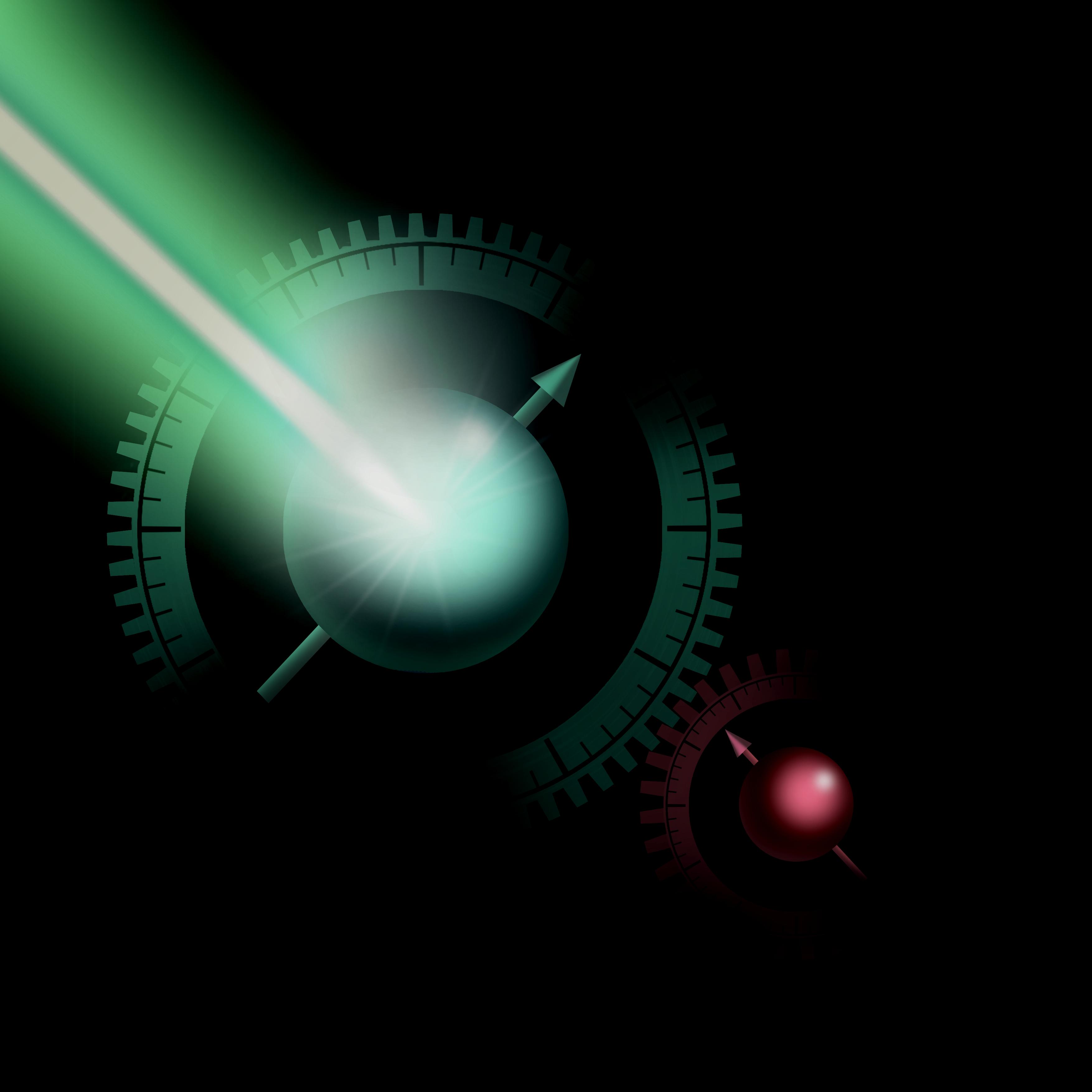1, Quantum Computation and Quantum Simulation
The possibility of building quantum computing machines with application of quantum mechanics has greatly changed human understanding of the nature of computation, and also attracted substantial interests in the active manipulation of the quantum world as well.In the computational aspect of view, it is generally thought that compared with classical computers (Turing machine), quantum computers are essentially more powerful. For some classically intractable problems, quantum algorithms may provide higher efficiency.It is one central challenge in quantum computation research field to explore the potential power of quantum algorithm. As there are still not many quantum algorithms discovered so far, which shows the urgent need for different types of quantum algorithms that will make other classes of problems accessible to efficient solutions. We will concentrate on the experimental implementation of quantum algorithms using different quantum systems, e.g. nuclear-spin systems, NV-center in diamond.
What type of computer can we use to simulate quantum systems? Certainly the classical computer is not the right choice. Although it can deal with tremendous common problems at present, when the target system is quantum mechanical, whose evolution obeys the Schrödinger equation, the classical computer unfortunately fails. Suppose that the system size scales up and expands rapidly. Then the computational cost grows exponentially and will soon exceed the capacity of any current computers. In 1982, Richard Feynman presented a path to solve this problem: ‘… there is to be an exact simulation, that the computer will do exactly the same as nature’. The idea of quantum simulation, using controllable quantum systems to mimic other quantum systems, was suggested for the first time. Lloyd proved that universal quantum simulators can be built with quantum computation architecture, whose required resources scale polynomially with the size of the simulated system.
Compared with quantum algorithms, which, in general, require thousands of qubits to surpass classical computing (e.g. Shor's quantum factorization algorithm), a quantum simulator could be realized with merely tens of qubits. Moreover, quantum simulation is less demanding than quantum computing because, typically, it does not require either explicit quantum gates or error corrections. Furthermore, the level of coherent control techniques for quantum systems necessary for the physical realization of quantum simulation is now within reach. Therefore, quantum simulation is attracting plentiful interest in an enormous range of fields, including quantum chemistry, materials science, quantum many-body problems, condensed matter physics, etc. During the past few years, several quantum simulation algorithm designs have been proposed, which were engineered for particular problems. Pioneering experiments were first implemented in nuclear magnetic resonance (NMR) and other quantum systems.
2, Quantum Sensing
Quantum metrology exploits quantum effect to achieve higher precision than traditional methods performed in classical framework, or detect objects inaccessible to classical methods. Using an atomic single spin quantum sensor, namely nitrogen-vacancy center, people can conduct nanoscale measurements of multiple physical parameters, such as magnetic field, electric field, temperature and stress. NV center has very stable optically detected magnetic resonance properties under extreme temperature, pressure and complex environments, thus suitable for wide range of applications. Our research interest is to develop microscopic magnetic resonance techniques based on NV center, and apply it to fundamental physics, chemistry, material science and life science, to solve relevant critical problems in those areas.
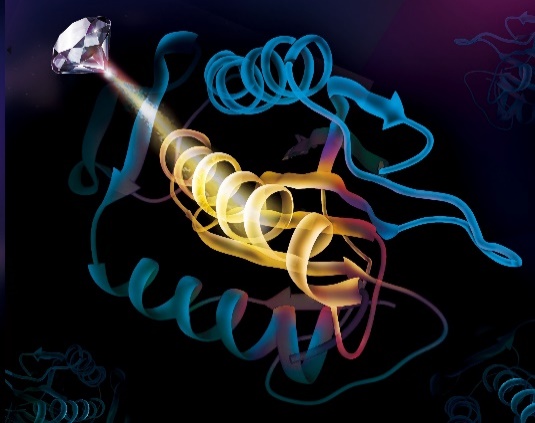
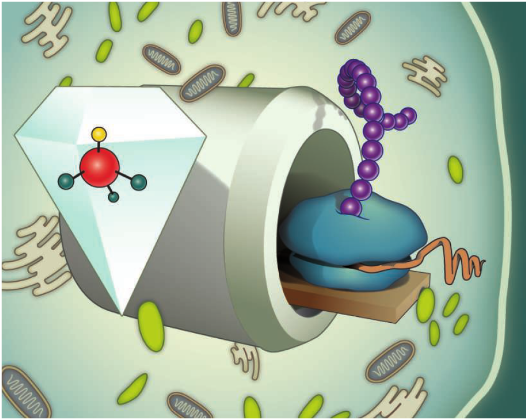
3、Quantum Devices
NV center based quantum devices
NV center in diamond has recently developed as a leading candidate for quantum information technology thanks to its outstanding spin property. Our lab aims to develop diamond based quantum device by combing the electron spin, nuclear spin and optical photon. To achieve this goal, we deeply engage in multidisciplinary research including diamond material engineering, nanofabrication, spin control techniques to address the frontier scientific issues.
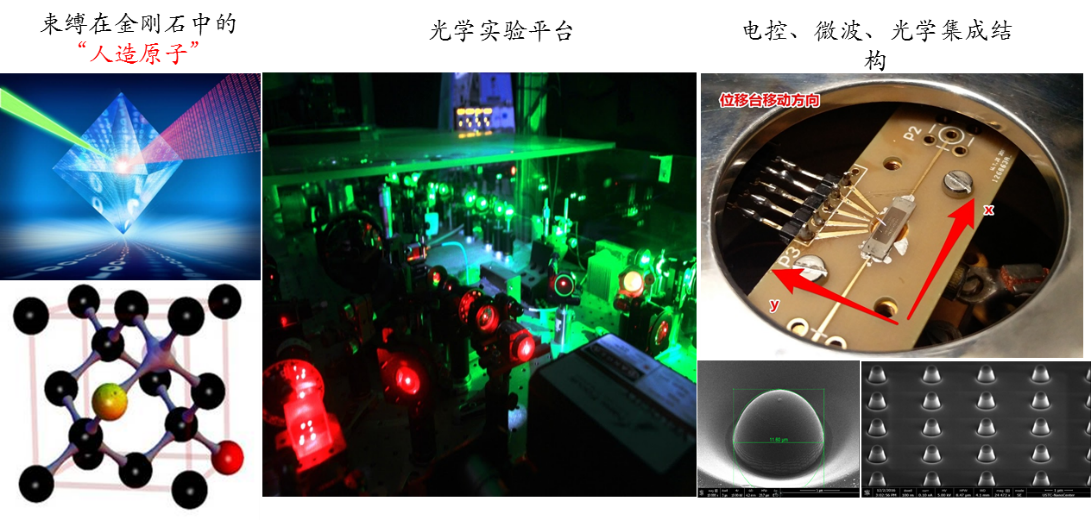
Silicon based quantum devices
Silicon quantum computing has drawn great attention of both scientific researchers and the industrial sector. It’s appealing for not only its compatibility with the existing semiconductor fabrication technology but the long spin relaxation and coherence times that are essential for completing the calculation algorithm accurately. Especially in the purified 28Si host materials, record-long coherence times have been demonstrated, with 0.5s for the electron spin and 30s for the nuclear spin [Nat. Nano. 9, 987(2014)].
This project aims to solve the following problems by utilising the high energy resolution spectroscopy demonstrated on a single erbium atom in silicon [Nature 497, 91(2013)]:
Quantum control of a single atom in silicon and coupling between two adjacent atoms (Fig. 1b-d).
Strong coupling between a single atom and an optical cavity, and long-range coupling between two single atoms via optical-cavity mode (Fig. 1a).
Integrated quantum circuits with single atom qubits in silicon.
Precise measurement based on quantum systems such as single atoms and other nano-structures.
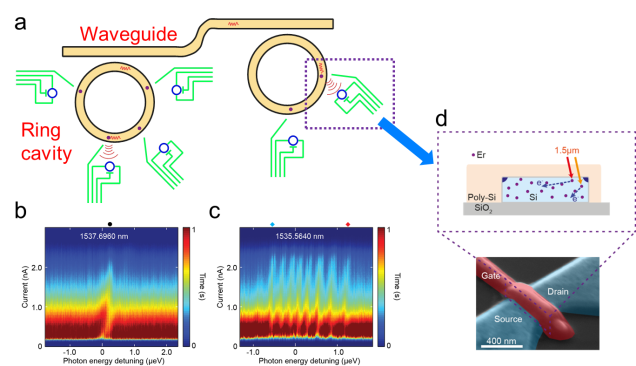
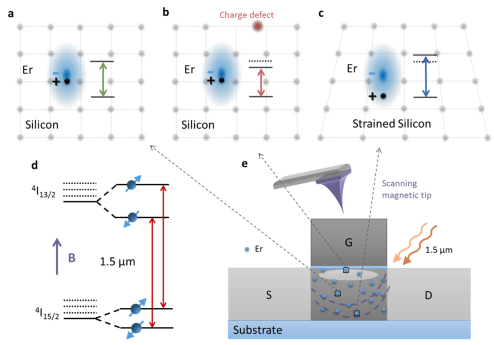
Quantum devices with quantum nanoelcetronics
Oxide materials host nearly all the phenomena one can find in condensed matter physics. Many of these exotic phenomena can be precisely designed and engineered in artificial oxide heterostructures thanks to the recent advancement in material growth methods. Here in Cheng research group, we “sketch” quantum devices on an artificial oxide “canvas” using a sharp atomic force microscope tip, a technique originated from the Levy group in the University of Pittsburgh. Inherent of correlated electron phenomena in oxides, these quantum devices can be superconducting nanowires, single electron/pair transistors or ballistic electron pair waveguides, whose rich properties are absent in traditional semiconductors. Meanwhile, we develop novel nanoscale imaging techniques at milliKelven temperatures to reveal and control the structural, electronic and magnetic properties of quantum devices. Our long term goal is to build a universal quantum platform for exploring problems in fundamental condensed matter physics, quantum computing using Majorana zero modes and solid state quantum simulation.
More information can be found via group website epsilon.ustc.edu.cn .
4、Foundations of Quantum Physics
Foundations of quantum physics: Quantum Mechanics and the Theory of Relativity are two cornerstones of modern physics. Hilbert space (a complete inner-product linear space) plays a central role in Quantum Mechanics, except scattering theory. However, because of the energy-based filed theory, the fundamental interaction of gravitation is nonlinear, according the Einstein filed equations. A conflict between Quantum Mechanics and the Theory of Relativity will certainly happens in a special regime or scale. Generally, Quantum Mechanics deals with the microworld very well, while Theory of Relativity usually deals with the world of very large (cosmogony). The macroscopic quantum phenomenon is one of the most important proof of Quantum Mechanics. Until now, it’s unclear that whether macroscopic objects obey quantum mechanics rule. Globally, a number of groups aim to observe the macroscopic quantum effect on a much larger scale than atoms. We make use of single spin coupled to nano-mechanical as well as low dimension system (spin wave, edge state etc. ) to reach these purposes. One of challenge for these goals is strong coupling between single spin and these macroscopic element. By controlling the single spin states, it is possible to realize quantum control of these macroscopic state. The current research topic includes:
1, Artificial mechanical topological structure
2, Nano-mechanical system based on electric-magnetic levitation
3, Interaction of electron spin and 2D magnetism
5、Related Quantum technology
Quantum technology is a new field that integrates quantum mechanics with quantum engineering. Combining control theory in engineering, computer science, and electronics with the principles of quantum mechanics, we use quantum technology to achieve effective control of quantum systems. As a core element of many cutting-edge scientific areas, the research of quantum technology will help people understand the basic scientific problems of quantum physics at a deeper level and greatly broaden the research dimensions of quantum mechanics. Moreover, it promotes the development of quantum information, quantum metrology and many other cutting-edge research. The unique features of quantum systems such as quantum collapse, coherence and decoherence effect have brought about huge challenges, which are completely different from traditional classic technologies. Meanwhile it provides incomparable opportunities and superiorities that traditional technology cannot match.
